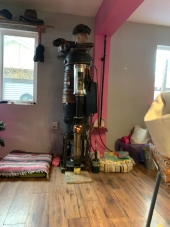posted 12 years ago
Thomas, i don't know if you're aware of the "half barrel system" but along thoses lines, i've been thinking lately about something similar. Everybody is on about monolithic mass. But Matthewalker developed the half barrel system, where you cut a barrel in half lenghtwise, and put the two halves in a bench, making a bell. I took on his idea, and thought, if using fist sized rocks above the bell, and having an air inlet and outlet , with forced air on one side, to exctract the heat out of the rocks. Ok, fist sized rocks, or a smidge bigger to allow convection of air in between them to charge them, and allow for forced air movement. Smaller, and you get traped air which insulates. Or you could make a criss cross of bricks too. Use a flat bell in that case, like an old home heating oil tank, (well we sometimes have square ones over here, i bet you do too.) Just an idea.





















































